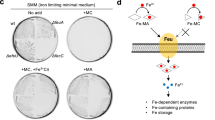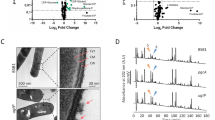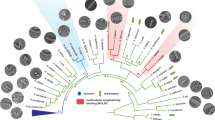Abstract
The cell wall is an essential structure for virtually all bacteria, forming a tough outer shell that protects the cell from damage and osmotic lysis. It is the target of our best antibiotics. L-form strains are wall-deficient derivatives of common bacteria that have been studied for decades. However, they are difficult to generate and typically require growth for many generations on osmotically protective media with antibiotics or enzymes that kill walled forms. Despite their potential importance for understanding antibiotic resistance and pathogenesis, little is known about their basic cell biology or their means of propagation. We have developed a controllable system for generating L-forms in the highly tractable model bacterium Bacillus subtilis. Here, using genome sequencing, we identify a single point mutation that predisposes cells to grow without a wall. We show that propagation of L-forms does not require the normal FtsZ-dependent division machine but occurs by a remarkable extrusion-resolution mechanism. This novel form of propagation provides insights into how early forms of cellular life may have proliferated.
This is a preview of subscription content, access via your institution
Access options
Subscribe to this journal
Receive 51 print issues and online access
$199.00 per year
only $3.90 per issue
Buy this article
- Purchase on Springer Link
- Instant access to full article PDF
Prices may be subject to local taxes which are calculated during checkout



Similar content being viewed by others
References
Rothfield, L., Taghbalout, A. & Shih, Y. L. Spatial control of bacterial division-site placement. Nature Rev. Microbiol. 3, 959–968 (2005)
Weiss, D. S. Bacterial cell division and the septal ring. Mol. Microbiol. 54, 588–597 (2004)
Höltje, J. V. Growth of the stress-bearing and shape-maintaining murein sacculus of Escherichia coli . Microbiol. Mol. Biol. Rev. 62, 181–203 (1998)
Klieneberger, E. The natural occurrence of pleuropneumonia-like organisms in apparent symbiosis with Streptobacillus moniliformis and other bacteria. J. Pathol. Bacteriol. 40, 93–105 (1935)
Allan, E. J., Hoischen, C. & Gumpert, J. Bacterial L-forms. Adv. Appl. Microbiol. (in the press)
Joseleau-Petit, D. et al. Unstable Escherichia coli L-forms revisited: Growth requires peptidoglycan synthesis. J. Bacteriol. 189, 6512–6520 (2007)
Allan, E. J. Induction and cultivation of a stable L-form of Bacillus subtilis . J. Appl. Bacteriol. 70, 339–343 (1991)
Daniel, R. A. & Errington, J. DNA sequence of the murE-murD region of Bacillus subtilis 168. Gen. Microbiol. 139, 361–370 (1993)
Leaver, M. & Errington, J. Roles for MreC and MreD proteins in helical growth of the cylindrical cell wall in Bacillus subtilis . Mol. Microbiol. 57, 1196–1209 (2005)
Murray, T., Popham, T. & Setlow, P. Bacillus subtilis cells lacking penicillin-binding protein 1 require increased levels of divalent cations for growth. J. Bacteriol. 180, 4555–4563 (1998)
Rogers, H. J., Thurman, P. F. & Buxton, R. S. Magnesium and anion requirements of rodB mutants of Bacillus subtilis . J. Bacteriol. 125, 556–564 (1976)
Formstone, A. & Errington, J. A magnesium-dependent mreB null mutant: Implications for the role of mreB in Bacillus subtilis . Mol. Microbiol. 55, 1646–1657 (2005)
Gilpin, R. W., Young, F. E. & Chatterjee, A. N. Characterization of a stable L-form of Bacillus subtilis 168. J. Bacteriol. 113, 486–499 (1973)
Burmeister, H. R. & Hesseltine, C. W. Induction and propagation of a Bacillus subtilis L-form in natural and synthetic media. J. Bacteriol. 95, 1857–1861 (1968)
Gilpin, R. W. & Nagy, S. S. Time-lapse photography of Bacillus subtilis L-forms replicating in liquid medium. J. Bacteriol. 127, 1018–1021 (1976)
Margulies, M. et al. Genome sequencing in microfabricated high-density picolitre reactors. Nature 437, 376–380 (2005)
Moszer, I. et al. SubtiList: The reference database for the Bacillus subtilis genome. Nucleic Acids Res. 30, 62–65 (2002)
Fujisaki, S. et al. Cloning and nucleotide sequence of the ispA gene responsible for farnesyl diphosphate synthase activity in Escherichia coli . J. Biochem. 108, 995–1000 (1990)
Hosfield, D. J. et al. Structural basis for bisphosphonate-mediated inhibition of isoprenoid biosynthesis. J. Biol. Chem. 279, 8526–8529 (2004)
Joly, A. & Edwards, P. A. Effect of site-directed mutagenesis of conserved aspartate and arginine residues upon farnesyl diphosphate synthase activity. J. Biol. Chem. 268, 26983–26989 (1993)
Domingue, G. J. & Woody, H. B. Bacterial persistence and expression of disease. Clin. Microbiol. Rev. 10, 320–344 (1997)
Wyrick, P. B. & Rogers, H. J. Isolation and characterization of cell wall-defective variants of Bacillus subtilis and Bacillus licheniformis . J. Bacteriol. 116, 456–465 (1973)
Ward, J. B. Peptidoglycan synthesis in L-phase variants of Bacillus licheniformis and Bacillus subtilis . J. Bacteriol. 124, 668–678 (1975)
King, J. R., Prescott, B. & Caldes, G. Lack of murein in a formamide-insoluble fraction from the stable L-form of Streptococcus faecium . J. Bacteriol. 102, 196–197 (1970)
Beall, B. & Lutkenhaus, J. FtsZ in Bacillus subtilis is required for vegetative septation and for asymmetric septation during sporulation. Genes Dev. 5, 447–455 (1991)
Claessen, D. et al. Control of the cell elongation-division cycle by shuttling of PBP1 protein in Bacillus subtilis . Mol. Microbiol. 68, 1029–1046 (2008)
Razin, S., Yogev, D. & Naot, Y. Molecular biology and pathogenicity of mycoplasmas. Microbiol. Mol. Biol. Rev. 62, 1094–1156 (1998)
Glockner, F. O. et al. Complete genome sequence of the marine planctomycete Pirellula sp. strain 1. Proc. Natl Acad. Sci. USA 100, 8298–8303 (2003)
Kandler, O. & Konig, H. Cell wall polymers in Archaea (Archaebacteria). Cell. Mol. Life Sci. 54, 305–308 (1998)
Margolin, W. Themes and variations in prokaryotic cell division. FEMS Microbiol. Rev. 24, 531–548 (2000)
Hanczyc, M. M., Fujikawa, S. M. & Szostak, J. W. Experimental models of primitive cellular compartments: Encapsulation, growth, and division. Science 302, 618–622 (2003)
Jones, L. J. F., Carballido-López, R. & Errington, J. Control of cell shape in bacteria: Helical, actin-like filaments in Bacillus subtilis . Cell 104, 913–922 (2001)
Abhayawardhane, Y. & Stewart, G. C. Bacillus subtilis possesses a second determinant with extensive sequence similarity to the Escherichia coli mreB morphogene. J. Bacteriol. 177, 765–773 (1995)
Soufo, H. J. & Graumann, P. L. Actin-like proteins MreB and Mbl from Bacillus subtilis are required for bipolar positioning of replication origins. Curr. Biol. 13, 1916–1920 (2003)
Vicente, M., Gomez, M. J. & Ayala, J. A. Regulation of transcription of cell division genes in the Escherichia coli dcw cluster. Cell. Mol. Life Sci. 54, 317–324 (1998)
Acknowledgements
We thank D. Swan for assistance with bioinformatics; A. Danchin for providing unpublished sequence data; E. J. Allan for providing the L-form strain that sparked our interest; T. Davey and V. Thompson of the Electron Microscopy Research Service of Newcastle University for technical assistance with electron microscopy; S. Gruber for help with quantitative real time PCR; J.-W. Veening and H. Murray for supplying strains and advice; and D. Claessen, K. Gerdes, H. Murray and W. Vollmer for critical reading of the manuscript. M.L. was supported by the UK Biotechnology and Biological Sciences Research Council. P.D.-C. was supported by an EMBO Long-Term Fellowship.
Author Contributions M.L. and J.E. designed the research and wrote the manuscript. M.L. performed the experiments. P.D.-C. constructed plasmids and strains and contributed to discussions. J.M.C. performed the genome sequencing. R.A.D. constructed strains, and contributed to discussions and the design of the research. All authors commented on the manuscript.
Author information
Authors and Affiliations
Corresponding author
Supplementary information
Supplementary Information
This file contains Supplementary Results and Discussion, Supplementary Tables 1-2, Supplementary References, Supplementary Figures 1-7 with Legends and Supplementary Movies Legends 1-4 (PDF 3244 kb)
Supplementary Movie 1
This file shoes time-lapse microscopy of a field of growing L-forms. (See file s1 for full legend). (AVI 4176 kb)
Supplementary Movie 2
This file shows time-lapse microscopy of an L-form producing an extrusion that resolves to form multiple progeny. (See file s1 for full legend). (AVI 4718 kb)
Supplementary Movie 3
This file shows time-lapse microscopy of an L-form dividing to produce pairs of progeny. (See file s1 for full legend). (AVI 1228 kb)
Supplementary Movie 4
This file shows time-lapse microscopy showing many small bodies erupting form the surface of a large L-form. (See file s1 for full legend). (AVI 4223 kb)
Rights and permissions
About this article
Cite this article
Leaver, M., Domínguez-Cuevas, P., Coxhead, J. et al. Life without a wall or division machine in Bacillus subtilis. Nature 457, 849–853 (2009). https://doi.org/10.1038/nature07742
Received:
Accepted:
Published:
Issue Date:
DOI: https://doi.org/10.1038/nature07742
This article is cited by
-
Direct observation of a crescent-shape chromosome in expanded Bacillus subtilis cells
Nature Communications (2024)
-
The reproduction process of Gram-positive protocells
Scientific Reports (2024)
-
L-form conversion in Gram-positive bacteria enables escape from phage infection
Nature Microbiology (2023)
-
On the mechanisms of lysis triggered by perturbations of bacterial cell wall biosynthesis
Nature Communications (2023)
-
Endocytosis-like DNA uptake by cell wall-deficient bacteria
Nature Communications (2022)
Comments
By submitting a comment you agree to abide by our Terms and Community Guidelines. If you find something abusive or that does not comply with our terms or guidelines please flag it as inappropriate.



